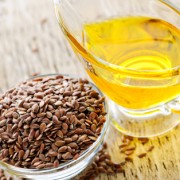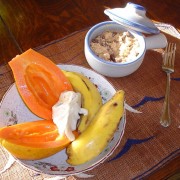Gerson Protocol: The Role of Protein, Carbohydrates and Fats
What’s So Different About the Gerson Diet?
People often comment that the Gerson diet is similar to many other nutritional approaches. It may be similar, but it is not the same. The macrobiotic approach, for example, recommends cooked foods almost exclusively and is high in sodium. Another dietary approach recommends large quantities of nuts and seeds. Still another stresses the importance of pH balance in foods. The Ann Wigmore diet recommends raw foods exclusively.
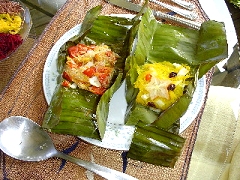 All of these diets have their supporters, and they all have successfully treated some patients. There are many different schools of thought about how diet affects health and many different paths to wholeness. The approach you take to your own healing must be your own decision, but we encourage you to choose one approach and stick with it, adding aspects from other approaches only when they are known to be compatible. The Gerson Therapy usually is not effective if its dietary guidelines are mixed with those from other treatments. While the Gerson diet is similar to, and has served as the foundation for, many other nutritional healing programs, its guidelines activate specific biochemical processes that promote healing in a unique way.
All of these diets have their supporters, and they all have successfully treated some patients. There are many different schools of thought about how diet affects health and many different paths to wholeness. The approach you take to your own healing must be your own decision, but we encourage you to choose one approach and stick with it, adding aspects from other approaches only when they are known to be compatible. The Gerson Therapy usually is not effective if its dietary guidelines are mixed with those from other treatments. While the Gerson diet is similar to, and has served as the foundation for, many other nutritional healing programs, its guidelines activate specific biochemical processes that promote healing in a unique way.
Consistency Counts!
The foods and juices consumed on the Gerson diet constitute its primary prescription for healing, comparably to a drug in allopathic treatment. Significant deviation from the diet can be as serious for a Gerson patient as missing an insulin shot can be for a diabetic, or as missing a chemotherapy or radiation appointment can be for a cancer patient undergoing an allopathic treatment.
We have found that the best results are achieved by following these guidelines to the letter. Of course, we recognize that sometimes it will be impossible to meet all of the guidelines, whether for logistical, financial or other reasons, and many of those who must “cut corners” will still achieve optimal healing with the Gerson method. Rare, mild deviation from the therapy does not seem to affect outcomes significantly.
A patient will not fail to heal simply because he misses one glass of juice a couple of times in a month. A patient will not fail if she must make use of commercial produce occasionally, when organic produce is unavailable. A patient, will however, reduce his chances of success if he cuts too many corners. How many corners can he cut? There is no good answer to that question, because every patient, every diagnosis, responds differently to the Gerson Therapy.
On the other hand, many patients have followed the guidelines in Dr. Gerson’s book, A Cancer Therapy, without medical assistance, and have healed themselves, but the Gerson Therapy must not be considered a “paint by numbers” approach to healing. Care is optimal when individually supervised by a trained (and experienced) Gerson practitioner.
Review of the Detoxification Diet and Nutrition of the Gerson Therapy
Much of degenerative disease lies in the inability of the gastro-intestinal tract and the cells to absorb nutrients and eliminate toxicity at the cellular level. The cell needs energy for healing and regeneration and carbohydrates provide the major source of energy. Degeneration occurs if body tissues are mobilized and broken down by the gluco-corticoid hormones and if proteins and fats are used as the main energy source due to nutritional deprivation. This is equivalent to burning “dirty fuels.”
Insulin is a key factor at cell membrane level where it acts to ensure the acceptance of glucose. If this process is inefficient, blood stream levels of insulin remain raised and blood glucose fails to fall, triggering further secretion of insulin. Today there appears to be an increase in diabetes, hyperinsulinanemia and late onset diabetes in children.
The reason why the cell membrane deteriorates and is not responsive to insulin is due to the prolonged use of damaged fats, such as polyunsaturated fats and cooking oils that are rendered biologically inert and may be toxic. This, together with cholesterol and saturated fats, clog the cell membrane, inhibiting signals and transfer and disrupts the whole energy system setting off a fermentation process. The cell membrane is composed of a double layer of fatty acids with protein “gateways”. It is reliant on adequate intake of the corrects fats for membrane integrity and efficiency. A cell membrane becomes increasingly inert due to the ingestion of the incorrect types of dietary fats leading to uncontrolled inflammatory mechanisms and a diminishing response to hormone stimuli.
As healing and regeneration take place slowly, the diet must be applied rigidly over a long period of time. Within 18 months to 2 years one can notice a substantial difference as a significant amount of body tissue (cells) have been replaced and repaired. Long-term compliance and a holistic approach are vital to overcoming disease states. We need to recognize that what you eat today is your cells and tissue of tomorrow and it take a considerable period to increase the vitality and resistance of the body to overcome chronic degenerative disease.
Carbohydrates
 Foods such as oatmeal, potatoes, vegetables and fruit provide the chief source of clean fuel that will provide energy for a recovering patient but must be taken in larger quantities, as they are low in kilo-joules. On the Gerson Therapy the high vegetable content is taken mostly in juice form that provides sufficient energy for daily energy requirements and the higher energy demand of regeneration. When carbohydrates are oxidized they do not leave an acidic waste in the body as do protein and fats. The end products are carbon dioxide and water that promote an alkaline environment. This encourages the elimination of sodium from the tissues, reduces toxicity and acidity and enhances the passage of potassium into the cell.
Foods such as oatmeal, potatoes, vegetables and fruit provide the chief source of clean fuel that will provide energy for a recovering patient but must be taken in larger quantities, as they are low in kilo-joules. On the Gerson Therapy the high vegetable content is taken mostly in juice form that provides sufficient energy for daily energy requirements and the higher energy demand of regeneration. When carbohydrates are oxidized they do not leave an acidic waste in the body as do protein and fats. The end products are carbon dioxide and water that promote an alkaline environment. This encourages the elimination of sodium from the tissues, reduces toxicity and acidity and enhances the passage of potassium into the cell.
It is essential that the cell respond to insulin for digestion at cell level and healing of the body. A therapy loaded with carbohydrates will promote good insulin response, however, many people with degenerative disease have degrees of carbohydrate intolerance due to their weakened digestive system. This will be evident in the gut and in other systems such as symptoms of low blood sugar (lethargy, fatigue, poor concentration, mood swings, panic attacks, hot and cold sweats, etc) and ‘fuzzy’ head after ingesting carbohydrates. Improvements from these symptoms can take days to months to occur, particularly in Chronic Fatigue Syndrome. A person may feel unwell initially on this type of diet but the all important uptake of potassium will slowly improve at the cellular level.
Fats
The diet must contain no fats except for flaxseed oil. Flaxseed oil contains both fatty acids linolenic and linoleic acid, but is richer in the former omega 3 series. The biologically active, unsaturated oils belong to either the w6 series (linoleic) or w3 series (linolenic). When these molecules are transformed through heating, refining and oxidation, they lose their electrical potential, cannot be incorporated instructural lipids, and are used only as fuel.
Essential Fatty Acids (EFA’s) will become part of the membrane of new cells and will also dislodge the cholesterol from arteries and old cell membranes causing initial rise in blood levels of cholesterol. Dr. Gerson initially eliminated all fat with cancer patients as he found that it encouraged tumor growth. Later he found that cold-pressed and organic flaxseed oil at the dose of 2 tablespoons (20 mls) daily in the first month and then reduced to 1 tablespoon was the maximum allowable.
The outer membrane of the cell and the membranes of the organelles within the cells cover a huge surface area where much of the enzyme activity, energy transfer and oxidation of the cell takes place. A healthy membrane with EFA’s present can store energy and attract oxygen into the cell. This is a crucial factor in cell metabolism, particularly to the brain, and a deficiency of EFA’s leads to oxygen starvation by the cell (Budwig 1992).
Proteins
Protein is required for growth and tissue maintenance but ingesting excess to our requirements creates acidity and strains the kidney that eventually affects the heart. The reason for this is the body does not lay down excess protein but converts it to carbohydrate or fat by the liver. The nitrogenous portion (amine) becomes urea and is eliminated by the kidneys. Urea is not only a poison, but also a diuretic, increasing calcium loss and contributing to osteoporosis. This progressive dehydration accelerates the ageing process, degeneration and our capacity for hydration. With that comes hardening which ultimately leads to decrease in functional capacity seen in wrinkled skin, brittle spinal discs, hardened arteries, brittle bones and stiff joints to name just a few.
Protein metabolism is controlled by various hormones, and after the growth hormone drops off at around age 30, high protein intake will not increase body muscle mass. Exercising increases the muscles capacity to store carbohydrates, as muscles do not use protein for energy.
Dr. Gerson found that inclusion of protein in the diet reduced sodium elimination and slowed the process of detoxification down. The more acidity you produce from a high protein intake, the greater the amount of sodium absorbed by the kidneys. He also observed that dietary protein stimulated tumor growth, but that when restricted for a short period (6-12 weeks), the immune profile changed and the white T-cell count improved. This reinforced the immune response to tumors, fungi and viruses (Gerson 1999). An adverse effect on the immune system is noted after this period so a form of soured milk product is introduced. The maximum amount allowed is 8 oz/200 g (1 cup) yogurt or 4 oz/ 100g pot cheese. Raw, soured milk products are pre-digested by the bacterial conversion of lactose to lactic acid but it is increasingly difficult to find raw skimmed milk. The pasteurization process distorts the protein and kills the natural enzymes (Fallon 1995).
Dr. Gerson used the juice of fresh, raw veal liver and patients responded very well to the therapy. Due to cross-contamination with campylobacter at abattoirs today, it is generally unsafe for immune-compromised patients to do liver juicing.
Small amounts of protein taken in its raw form may not be a burden on the system. Cooked protein, however, changes its structure from a globular to a straightened form that is not recognizable to the body’s digestive enzymes for example, the change in the white of egg. The impaired digestive system of an older or sick person will show symptoms of bloating, flatulence, heartburn, indigestion, irritable bowel syndrome and allergies. Partially broken-down proteins enter the systemic circulation as toxic and foreign, and if the liver cannot cope in mopping them up, inflammatory reactions in the tissues and joints will arise.
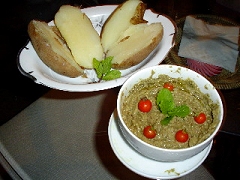 In the initial 6-12 weeks on the Gerson Therapy potatoes, oatmeal and carrots are the primary source of protein. The protein molecule is less damaged due to slow cooking of vegetables which also shortens the long carbohydrate chains and makes digestion easier, thus vegetables generally taste sweeter in their cooked state. Cooking at low temperatures also ensures maximum breakdown of indigestible fibers, maintains the integrity of the enzymes as well as the conversion of starches to easily digestible sugars.
In the initial 6-12 weeks on the Gerson Therapy potatoes, oatmeal and carrots are the primary source of protein. The protein molecule is less damaged due to slow cooking of vegetables which also shortens the long carbohydrate chains and makes digestion easier, thus vegetables generally taste sweeter in their cooked state. Cooking at low temperatures also ensures maximum breakdown of indigestible fibers, maintains the integrity of the enzymes as well as the conversion of starches to easily digestible sugars.
Cooking water for food reaches a maximum of 100ºC; fried food can reach 215ºC and some processing methods such as puffed rice and cereals use high temperatures and 1500 pounds/square inch pressure. The more damaged the protein, the more toxic it becomes in the body. Recent research in Sweden revealed that starch-based foods that have been cooked or processed at high temperatures contain high levels of acrylamide, a chemical used in water and waste treatment, which is toxic and a potential carcinogen. The list of foods include puffed cereal grains, biscuits, snack foods, French fries/potato crisps and chips.
Protein is found in most foods in different quantities. The following are approximate amounts:
Meat 20%
Raw grains 12%
Raw legumes 25%
Nuts 20%
Vegetables 2%
Fruits 0.5-3%
When grains and legumes are swollen with water when cooked, the protein content is reduced by two-thirds. The average requirement of protein is 1 g per kg of body weight that is the equivalent of 200 g meat or fish and 4 slices of bread (64 grams) in a 50-70 kg person. Initially on the Gerson Therapy, the amount of protein in the diet is approximately:
*
Later on in the therapy as the juices decrease and as the digestion strengthens, other foods can be included with discretion and understanding, starting with the lowest protein foods and moving up to grains (eg., brown rice and legumes). Nuts are high in fat so are added much later and need to be soaked overnight, which enables the protein and fat to chemically combine, making the fat water-soluble and easier to digest.
Many of these products need to be pre-digested if they are to be of nutrition benefit, even to those with a strong digestion. Many traditional indigenous cultures understand the need to prepare foods to make it more digestible and ensure that the nutrients become available. Natural souring, for instance, also contributes additional enzymes from the bacteria and their action on the sugars increases their food value. Salting, pickling and chemical preservatives, processed and refined foods are not healthy options for food preservation, and although they are used by the food industry in mass production, they should be entirely avoided.
Grains, legumes, and pulses are all seeds with the potential to sprout and produce. The anti-trypsin factor inhibits this process until conditions are favorable and allows for storage for long periods. This factor will also oppose human pancreatic enzymes and interfere with digestion. This can be prevented by semi -germinating the seeds in the following way:
1. Soak grains and legumes for 12 hours in pure water.
2. Rinse, drain and leave in a glass dish at room temperature covered with a damp cloth for 12 hours.
3. In hot humid climates, rinse again – do not let seeds go moldy.
4. Cook as normal.
Another problem with legumes, grains and seeds is the amount of phytate they contain. Phytate is found in the outer covering (bran) of the seed and binds magnesium, calcium, iron and zinc, stripping it from the body. Soybeans are high in phytate. Soaking neutralizes the phytates in seeds. This apples to the soaking of oats overnight as the enzyme phytase is produced which neutralizes the phytic acid and in the leavening of bread by the natural fermentation of flour in buttermilk or yogurt (we prefer the sour dough method as yeast is not easily digested in cancer patients).
Soybeans and soy products are forbidden on the detoxification diet as phytosterols inhibit thyroid function and are high in anti-trypsin. Phytates are associated with brain atrophy (Fallon 1995).
Juicing
The detoxification therapy is predominantly and could be too much for a weakened digestion to cope with. It is not only essential that the patients ingest and digest the correct nutrients, but that they absorb them. Fresh, live juices, free of fiber, which taxes the digestive system and inhibits absorption, are taken in large volume. These are rich in enzymes (amylase, protease and lipase), which are destroyed when heated at wet temperatures higher than 45ºC/117ºF and 85ºC/150ºF with dry heat. All natural foods contain living enzymes (amylase, protease and lipase), but the fresh juices ensure absorption and do not tax the pancreas to release greater amounts of digestive enzymes. A masticating action to produce the pulp that is then pressed results in twice the nutrient value. This is vital to the weak patient who needs these enzymes to support their digestive processes otherwise gas and bloating will ensue. An inefficient juicer wastes a large quantity of the vegetables and increases costs.
In order to provide the huge amounts of nutrients required by the nutritionally depleted cancer patient for healing, a large amount of organic food needs to be consumed on a daily basis. As the digestive system is usually impaired and of small capacity, some of this is juiced to promote maximum absorption with minimum effort. The volume of produce consumed daily amounts to about 20 lbs.
Bloating has been attributed to food combining, however it is essential on the Gerson Therapy to pulp the apples and vegetables together. The malic acid from apples enhances the uptake of nutrients from the vegetables. Apples are cored but not peeled, as the enzyme inhibitor in seeds impedes digestion. Pectin, which is high in green apples, stimulates the immune system. Organic food has significantly higher nutritional values and is chemically non-toxic.
Juices: 20 kg carrots
21 kg apples (cooking)
30 lettuces
4 bunches Swiss Chard
9 green pepper / capsicum
Food: 10 kg potatoes Soup ingredients
Fruit Soured milk products at 6-8 wks.
Rye sour dough bread 4 kg onions
5 kg tomatoes Oatmeal
Vegetable and salad ingredients (a wide variety ensures adequate intake of essential and trace nutrients).
Food Preparation
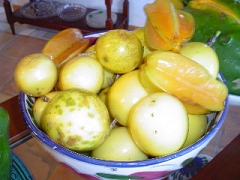 Cooking methods and enzyme supplements increase the complete digestion of starches and sugars, and ensure maximum absorption for the cancer patient. Undigested sugars will start to ferment and cause gas and bloating. The best way to prepare vegetables is to cook them slowly for 1 1/2 to 2 hours without water. This preserves the natural flavor and keeps them easily digestible. The cells burst, lose their minerals and go out of their colloidal or ‘gluey’ state and become difficult to absorb when cooked at high temperatures. To prevent burning, place a stainless steel heat diffuser plate under the sauce pan. Soup stock may be added (Hippocrates), or else sliced tomatoes, onions, leaks or apples added to give more fluid and improve the taste. Spinach water is too bitter for use and contains too much oxalic acid.
Cooking methods and enzyme supplements increase the complete digestion of starches and sugars, and ensure maximum absorption for the cancer patient. Undigested sugars will start to ferment and cause gas and bloating. The best way to prepare vegetables is to cook them slowly for 1 1/2 to 2 hours without water. This preserves the natural flavor and keeps them easily digestible. The cells burst, lose their minerals and go out of their colloidal or ‘gluey’ state and become difficult to absorb when cooked at high temperatures. To prevent burning, place a stainless steel heat diffuser plate under the sauce pan. Soup stock may be added (Hippocrates), or else sliced tomatoes, onions, leaks or apples added to give more fluid and improve the taste. Spinach water is too bitter for use and contains too much oxalic acid.
Vegetables are washed and scrubbed but not peeled or scraped. The reason for this is that important salts and minerals are deposited directly under the skin. Beetroots and potatoes are cooked in their skins (jackets) and with water. The soft bulk of cooked vegetables counteracts the effects of all the juices and raw salads, and provides plenty of nutrients. Cooked fruits and vegetables may be kept in a refrigerator overnight and warmed slowly with a little soup or tomato juice. Use grated, peeled or shredded food as soon as possible as it deteriorates rapidly, as do the green juices.
Baked vegetables are cooked slowly in a moderate oven (Gas 4, Electric 180ºC/350ºF) for 2 to 2 1/2 hours, in a covered casserole with a tightly fitting lid. Stewed vegetables are cooked in a heavy pot, preferably waterless, with a tight fitting lid, over a low heat. Simmered vegetables may be cooked with a small amount of liquid over a low heat. Boiled vegetables (sweetcorn, beetroot, artichoke) are placed in 1 inch of water, brought to the boil and then the heat lowered as much as possible, just keeping the liquid boiling.
It is not advisable to make casseroles too often as the dishes all taste the same. To stimulate appetite a variety of taste, color and consistency is important. Use only stainless steel, glass, pyrex, enamel, earthenware, cast iron and tinware cooking utensils. Do not use aluminium, Teflon or copper, pressure cookers, steam cookers or microwaves. Radiation and microwaves change the composition of food, making it difficult to assimilate and affection the immune system.
Patients who cannot chew and benefit from the digestive juices in the mouth do not do very well. The Hippocrates soup is passed through a food mill to break down any fibres and make the food more digestible. This may be kept in the refrigerator for 2 days and retains nutrient, if not enzyme, value. Any cooked vegetable could be prepared in mashed form for the very ill patient.
Also read about what to do, what steps to take if you have cancer.

